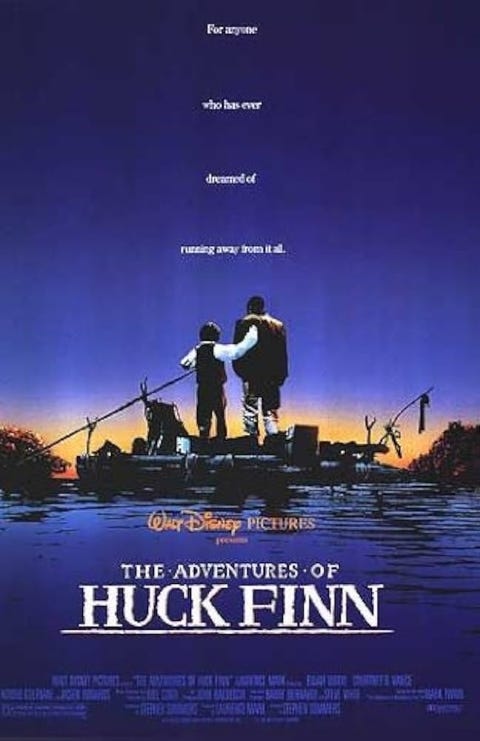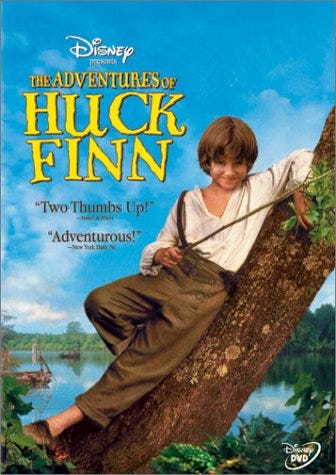Given Walt Disney’s well-documented love of Mark Twain and the great state of Missouri, it’s genuinely surprising that Twain’s work has appeared in this column exactly once, as the loose inspiration for the sci-fi comedy Unidentified Flying Oddball. That movie, a space race variation on Twain’s A Connecticut Yankee In King Arthur’s Court, wasn’t what anybody would call a faithful adaptation. It wasn’t until 1993, more than 25 years after Walt’s death, that the studio finally tackled one of Twain’s major works and remained surprisingly true to the source.
I truly have no idea why Walt himself never attempted to adapt either Tom Sawyer or Huckleberry Finn. Visitors to Disneyland could check out Tom Sawyer Island and ride a riverboat named after the author that Walt wanted so badly, he paid for it out of his own pocket. But these attractions, like Pirates Of The Caribbean at the time and It’s A Small World, weren’t tied to any Disney movies or TV projects.
I do wonder if part of his reticence had to do with the criticism he received over Song Of The South. While the movie itself remained in circulation until the late 1980s, Walt was reportedly taken aback by the controversy and protests that surrounded the film at the time of its release. Walt Disney did not enjoy being the target of criticism and wasn’t one to stir up trouble unnecessarily. If slavery and the Antebellum South were going to be problem areas, perhaps it would be best to avoid them altogether.
To his credit, writer-director Stephen Sommers does not skirt the darker issues raised by Twain’s book, although they are understandably somewhat muted and compressed for Disney purposes. Sommers was a graduate of USC Film School who had made a low-budget indie racing movie called Catch Me If You Can in 1989. Unfortunately, his original US distributor ended up going out of business before the film could be released. While it did reasonably well overseas, it barely existed here in the States and seemed to stop Sommers’ career before it could even get started. Setting Huck Finn up at Disney gave him a much-needed lifeline.
Twain’s 1884 novel, Adventures Of Huckleberry Finn, was, of course, a sequel to The Adventures Of Tom Sawyer. Sommers elected to bypass the original and jump straight in to the follow-up. This wasn’t entirely without precedent. Both the 1939 version starring Mickey Rooney and the 1960 movie with Eddie Hodges were stand-alone movies that make no reference to Tom. Disney would eventually circle back around to the first book but Sommers does a fine job filling us in on the necessary facts of Huck’s life, including his adoption by the Widow Douglas (played here by Dana Ivey) and the inheritance held in trust that prompts the return of Huck’s abusive, drunken Pap (menacingly played by a pre-Hellboy Ron Perlman).
Sommers and Mary Goldberg, the film’s casting director, had a real eye for talent. Ivey and Perlman are just the tip of a very large iceberg. Elijah Wood, already totally comfortable playing a character who spends most of the movie barefoot, is a believable and fun Huck. 11-year-old Wood had already been in several movies, perhaps most notably Barry Levinson’s Avalon, as well as Touchstone’s Paradise. Huck Finn was Wood’s second proper Disney project. In 1992, he played the title role in the TV-movie Day-O, a little girl’s imaginary friend who comes back to help drive her insane after she’s grown up into Delta Burke. It looks just about how you’d expect a Disney TV-movie from the ‘90s to look. Take that as you will.
Wood spends most of the film acting alongside Courtney B. Vance as Jim, the runaway slave who becomes Huck’s traveling companion. Vance had made a handful of appearances on film and TV, including the Vietnam drama Hamburger Hill and The Hunt For Red October. But he’d made a huge name for himself on stage, already racking up two Tony nominations for his work in August Wilson’s Fences and John Guare’s Six Degrees Of Separation. Wood and Vance have a natural chemistry that only gets stronger as the bond between Huck and Jim deepens.
Of course, no adaptation of Huckleberry Finn would be complete without The King and The Duke, the two con men who threaten to turn Jim in unless he and Huck play along with their schemes. Sommers cast a truly odd couple in the roles, pairing two actors from very different backgrounds who nevertheless form a terrific team. The Duke is played by Robbie Coltrane, then best known for comedic roles on the BBC and such films as Nuns On The Run before going on to global fame as Hagrid in the Harry Potter franchise. His partner, The King, is played by Jason Robards, last seen in this column in another literary adaptation, Something Wicked This Way Comes (although he’ll be turning up again on the Touchstone side very soon).
Sommers stacks even the smaller roles with instantly recognizable character actors, including Curtis Armstrong (perhaps still best known from the Revenge Of The Nerds movies, despite making countless other film and TV appearances since then), Frances Conroy (from Six Feet Under), James Gammon (soon to be seen over on the Touchstone side) and Paxton Whitehead (you may remember him as the snooty dean who butts heads with Rodney Dangerfield in Back To School). Also appearing in one of her first big roles is Anne Heche as Mary Jane Wilks, one of the sisters The King and The Duke attempt to bilk out of their fortune.
The movie hits most of the major highlights of Twain’s book, sanding down some of the roughest edges without losing either its charm or its resonance. It’s particularly impressive that Sommers doesn’t let Huck off the hook easily. As much as he loves Jim, he still wrestles with turning him in because slavery is just the way things are. Huck needs to learn why slavery is wrong for the story to have any meaning whatsoever. Wood and Vance play these scenes delicately and believably.
Honestly, a completely faithful film version of Twain’s novel would likely never be made, especially in today’s day and age. After all, the book is still routinely challenged in schools and libraries around the country. Any movie that uses the “N-word” as frequently as Twain does would almost certainly be slapped with an R rating these days. Despite this and other occasional instances of sanitization, the movie effectively captures the essence of Twain’s book.
A lot of that has to do with the casting, not to mention Sommers’ own screenplay. But special mention must be made of the look of the movie. Shot entirely on location in Mississippi by Janusz Kaminski, the images evoke the time and place of Twain’s novel. This was a fairly early credit for Kaminski before going on to numerous collaborations with Steven Spielberg, including his Oscar-winning work on Schindler’s List and Saving Private Ryan. Kaminski helps elevate the film a notch above other, more pedestrian-looking versions of the story.
Critics agreed that Disney had produced a worthy version of Twain’s story. The film opened on April 2, 1993, earning a little over $5 million and landing in second place behind (sigh) Cop And A Half. I don’t know what to tell you about that, other than a few more people wanted to see Burt Reynolds lose what remained of his dignity. Anyway, Huck Finn went on to earn around $24 million, making it a modest hit for the studio. I mean, it was no Cop And A Half but hey, you’ve gotta start somewhere.
The Adventures Of Huck Finn rejuvenated Stephen Sommers’ lagging career. He decided to stick around Disney and its adult-oriented offshoots for a few more years before moving on to bigger-budget blockbusters. We’ll see his name several more times. We’ll also see Huckleberry Finn again, although he won’t be played by Elijah Wood next time. Wood did have one more Disney project left in him before heading off to Middle-Earth, however. In 1997, he played The Artful Dodger in The Wonderful World Of Disney’s version of Oliver Twist, opposite Touchstone favorite Richard Dreyfuss as Fagin. One of the uncredited writers on that project was none other than Stephen Sommers. It really is a small world after all, especially if you work for Disney.
VERDICT: Disney Plus





